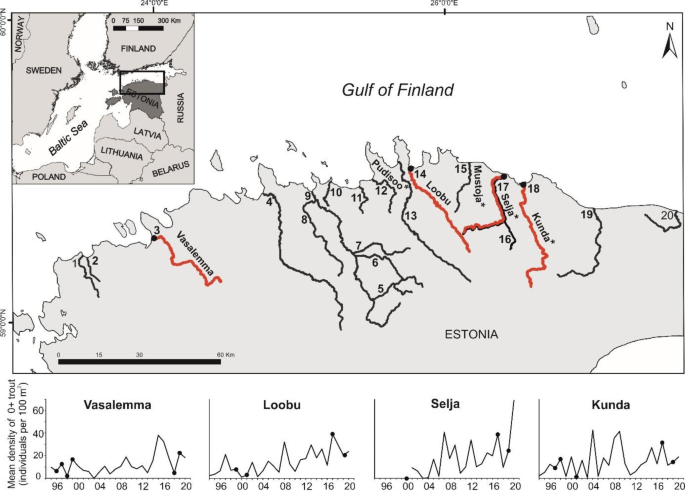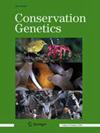近20年来波罗的海鳟鱼时空遗传结构的变化:放养的直接和间接影响
IF 1.7
3区 环境科学与生态学
Q2 BIODIVERSITY CONSERVATION
引用次数: 0
摘要
一些国家实施了放养计划,通过放养孵化场饲养的鱼类来提高鱼的丰度和产量。然而,由于种群规模的波动、放养历史以及孵化场养殖鱼类的潜在间接影响,通常很难预测这些因素将如何影响野生种群的遗传多样性和分化模式。本研究利用14个微卫星位点,通过评估放养对4个爱沙尼亚海鳟种群的直接和间接遗传影响程度,对种群遗传结构和时间变异进行了表征。我们的研究结果表明,在研究的海鳟种群中,相当大的时间变化结合了弱遗传结构。我们发现,在研究期间,遗传分化总体水平降低,遗传多样性增加,有效育种者数量(N b)增加。此外,我们发现孵化场种群的迁移率(m)在直接放养的种群和地理上靠近放养河流的非放养种群中最高。这项工作表明,孵化场释放影响了所研究的海鳟种群的遗传多样性和结构。然而,孵化场放养对野生鳟鱼种群适应性变异和适应性相关性状的影响还有待于更多信息丰富的遗传标记来揭示。本研究说明了海鳟种群遗传结构的动态性质,以及长期遗传监测对管理和保护的价值。本文章由计算机程序翻译,如有差异,请以英文原文为准。

Changes in the spatio-temporal genetic structure of Baltic sea trout (Salmo trutta L.) over two decades: direct and indirect effects of stocking
Abstract Several countries have implemented stocking programmes to enhance abundance and fish production by releases of hatchery-reared fish. However, due to fluctuations in population size, stocking history, and potential indirect effects of straying of hatchery-reared fish, it is often difficult to predict how these factors will affect genetic diversity and differentiation patterns among wild populations. This study characterized the population genetic structure and temporal variability of four Estonian sea trout populations by evaluating the degrees of direct and indirect genetic impacts of stocking over two decades using 14 microsatellite loci. Our results demonstrate considerable temporal change combined with weak genetic structuring among studied sea trout populations. We found a reduction of the overall level of genetic differentiation combined with the tendency for increased genetic diversity, and an effective number of breeders ( N b ) over the study period. Furthermore, we found that immigration rates ( m ) from hatchery stocks were highest in the population subjected to direct stocking and in non-stocked populations that were located geographically closer to the stocked rivers. This work suggests that hatchery releases have influenced the genetic diversity and structuring of studied sea trout populations. However, the impact of hatchery releases on the adaptive variation and fitness-related traits in wild trout populations remains to be revealed by more informative genetic markers. This study illustrates the dynamic nature of the population genetic structure of sea trout and the value of long-term genetic monitoring for management and conservation.
求助全文
通过发布文献求助,成功后即可免费获取论文全文。
去求助
来源期刊

Conservation Genetics
环境科学-生物多样性保护
CiteScore
3.80
自引率
4.50%
发文量
58
审稿时长
1 months
期刊介绍:
Conservation Genetics promotes the conservation of biodiversity by providing a forum for data and ideas, aiding the further development of this area of study. Contributions include work from the disciplines of population genetics, molecular ecology, molecular biology, evolutionary biology, systematics, forensics, and others. The focus is on genetic and evolutionary applications to problems of conservation, reflecting the diversity of concerns relevant to conservation biology. Studies are based on up-to-date technologies, including genomic methodologies. The journal publishes original research papers, short communications, review papers and perspectives.
 求助内容:
求助内容: 应助结果提醒方式:
应助结果提醒方式:


